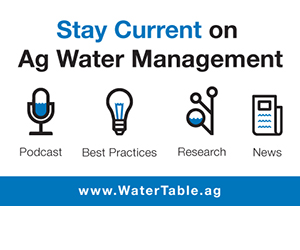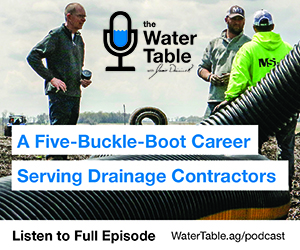| |
| |
 |
 |
| |
 |
|
@{mv_date_MMM d, yyyy}@ |
|
| |
 Approximately $500,000 in federal funding will be available. Previous projects supported include drainage water management systems, saturated buffers, two-stage ditches and more.
» Read more...
Approximately $500,000 in federal funding will be available. Previous projects supported include drainage water management systems, saturated buffers, two-stage ditches and more.
» Read more...
While nutrient leaching is a serious problem with significant consequences, it’s a mistake to think the drainage industry can’t innovate and improve things.
» Read more...
The all-day event will feature installation demonstrations for both a saturated buffer and a water control structure, as well as a water-gate valve demo.
» Read more...
|
| |
|
| |

The drainage industry is driven by the unsung heroes of agriculture– drainage contractors. Kent Rodelius from Prinsco reflects on his four-decade career serving these hardworking business owners, many of whom have a multi-generational, family culture. He shares stories about the evolution of the industry and his personal philosophy of hard work which he describes as “a five-buckle-boot day.”
» Listen now... |
| |
|
| |
 Bruce Shewfelt has spent most of his career focused on moving water – whether it’s bringing water into areas that are too dry or diverting water away from areas that are too wet. His work both in the public sector and in private consultation have led him around North America, working with some of the best minds in the biz and engaging in knowledge transfer including public speaking, publishing beneficial management practices and more. In this GroundBreakers podcast episode, Shewfelt shares how his career has evolved from its early days, what he’s learned and what he thinks the biggest challenges are in drainage and water management.
» Listen now...
Bruce Shewfelt has spent most of his career focused on moving water – whether it’s bringing water into areas that are too dry or diverting water away from areas that are too wet. His work both in the public sector and in private consultation have led him around North America, working with some of the best minds in the biz and engaging in knowledge transfer including public speaking, publishing beneficial management practices and more. In this GroundBreakers podcast episode, Shewfelt shares how his career has evolved from its early days, what he’s learned and what he thinks the biggest challenges are in drainage and water management.
» Listen now... |
| |
|
| |

It’s important to pay attention to drainage when analyzing your farm’s performance. Trimble’s WM-Drain® farm drainage solution, paired with WM-SubsurfaceTM design software, is a toolset that streamlines the survey, analysis, design, installation, and verification steps of surface and subsurface drainage. Complete all your drainage operations with one integrated solution providing significant benefits, such as: improving crop yields by up to 30%, maintaining a more developed root zone for better nutrient absorption, removing excess water from the field and lower plant stress, and reducing field compaction and minimize soil erosion.
» Learn more... |
| |
|
| |

|
| |
| |







